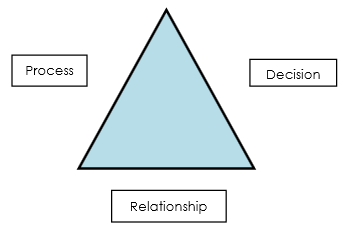The fairness triangle: creating a fair and satisfactory service experience
The fairness triangle is a useful tool to understand what concerns stakeholders have around decisions that impact them.
About the fairness triangle
When you are managing competing interests, it is helpful to be able to demonstrate and explain how you arrived at your decision in ways that don't come across as arbitrary or autocratic. Respecting the three sides of the fairness triangle will make it easier to explain how you arrived at a fair and balanced decision.
The three sides of the triangle are interrelated. If one of the components is weak, it will have a bearing on the perception of fairness and the decision is more likely to be contested.
The fairness triangle is adapted from "The Mediation Process: Practical Strategies for Resolving Conflict," by Christopher W. Moore, and "The Fine Art of Fairness: A Guide for Fair Practice," by Ombudsman Saskatchewan.
Image: the fairness triangle
The three sides of the triangle are:

Process
These are the steps taken to arrive at a decision and after a decision is made.
A strong decision making process includes:
- notice before a decision is made
- a chance to be heard
- confidence that the decision-maker has thoroughly and thoughtfully reviewed all the pertinent information
- belief that the decision-maker is impartial
- honest, meaningful, and understandable communications throughout the process
Decision
After a fair process, the:
- decision must stand up to scrutiny
- decision is in accordance with laws and regulations
- person making the decision has the authority to do so
- decision is made within a reasonable timeframe
- decision is based on evidence
- reasons for the decision are understandable and clearly communicated from the stakeholder's perspective
- decision is free from bias
- decision does not give rise to unnecessary hardship
Relationship
Taking into account the human factor and acknowledging that a stakeholder might have a different perspective than your own is another side of the triangle. This isn't about being warm and fuzzy. It's about using approaches that prevent situations from escalating into expensive, time-consuming and often embarrassing conflicts for you and for the department.
The human side of fairness is to:
- show respect, especially when you disagree
- be accessible: keep lines of communication open
- take time to understand the stakeholder's perspective
- respond by showing an understanding of the stakeholder's perspective
- acknowledge phone calls and emails in a timely way
- manage expectations around timeframes
- keep commitments made
- admit when you have made a mistake